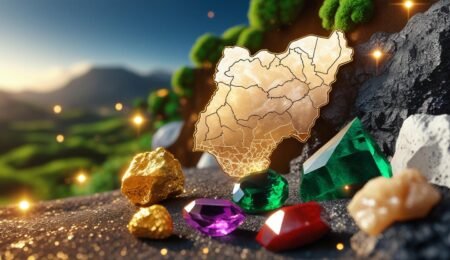Nigeria, often celebrated for its oil wealth, is quietly emerging as a gold mining powerhouse. With gold deposits spanning at least 17 states, the country’s Precambrian basement rocks and riverbeds hold untapped potential. This article maps Nigeria’s gold hotspots, analyzes government policies, and emphasizes the critical balance between profit and sustainability. For a deeper dive into locating these gold reserves, consider our comprehensive guide, Gold Map: The Ultimate Guide to Gold Deposits in Nigeria.
Geological Foundations of Nigeria’s Gold
Gold in Nigeria is primarily hosted in Precambrian schist belts (550–700 million years old) and alluvial deposits. These formations dominate the Northwest, North Central, and Southwest regions, with recent discoveries expanding prospects to the South-South and Southeast.
Gold-Bearing States: Verified Locations
Below is a regionally organized breakdown of confirmed gold deposits, cross-referenced with data from the Nigerian Geological Survey Agency (NGSA) and Mining Cadastre Office:
Northwest Nigeria
- Zamfara: Nigeria’s largest gold producer (source: NGSA). Illegal mining remains a challenge.
- Kebbi & Sokoto: Artisanal sites in Danko/Wasagu and Isa LGA.
- Kaduna: Lode gold in Birnin Gwari; linked to historic Zaria mines.
North Central Nigeria
- Niger State: Major deposits in Shiroro and Zungeru (schist belts).
- Nasarawa: Active exploration at Uke, near Wamba and Nasarawa Eggon.
- Kogi: Gold-quartz veins in Lokoja and Mopa-Muro.
Southwest Nigeria
- Osun: Home to the Segilola Mine (Nigeria’s first industrial gold mine, producing 80,000–100,000 oz/year).
- Ogun: Alluvial gold in Ijebu-Igbo and Imeko.
- Ekiti: Revival of pre-colonial sites in Ijero-Ekiti.
South-South Nigeria
- Edo: Alluvial deposits in Igarra and Okpekpe (verified by the NGSA).
- Cross River: Emerging traces in Akamkpa and Ikom Basin.
Southeast & Northeast Nigeria
- Anambra: Early-stage exploration in Aguleri (Anambra Basin).
- Bauchi & Taraba: Artisanal mining in Yelwa (Bauchi) and Sardauna (Taraba).
Government Policies: Formalizing Artisanal Miners
To curb illegal mining and boost transparency, Nigeria’s government has launched:
- Presidential Artisanal Gold Mining Initiative (PAGMI):
- Established Gold Souk hubs in Kebbi and Osun to purchase gold directly from Artisanal miners and standardize pricing.
- Central Bank of Nigeria (CBN) buys gold directly for reserves
- National Gold Policy (2022):
- Simplified licensing for artisanal miners via Artisanal Mining Leases (AML).
- Training programs for mercury-free processing (aligned with the Minamata Convention).
- Community Development Agreements (CDAs):
- Mandates revenue share for host communities
- World Bank-Backed MINDIVER Project:
- Aims to formalize 450,000 artisanal miners by 2025 through funding and tech support.
Challenges: Risks to Growth
- Illegal Mining: Fuels insecurity in Zamfara and Niger.
- Environmental Damage: Mercury pollution affects water in Osun and Kaduna.
- Data Gaps: Limited mapping in Anambra and Cross River.
The Sustainability Imperative
For Nigeria to harness gold sustainably, it must:
- Adopt Cleaner Technologies: Replace mercury with cyanide-free extraction
- Enforce Reclamation Laws: Restore degraded sites in Zamfara, Niger, and other states.
- Boost Community Engagement: Use CDAs to fund schools and hospitals in mining regions.
- Leverage Global Standards: Align with the London Bullion Market Association (LBMA) to access ethical gold markets.
Conclusion: Gold as a Catalyst for Balanced Growth
Nigeria’s gold reserves could generate billions annually, but success hinges on environmental safeguards, and social equity. Investors, miners, and regulators must collaborate to ensure gold mining becomes a force for inclusive development—not ecological ruin.
Ready to turn these hotspots into profitable ventures? Get your copy of Finding Gold in Nigeria: A Practical Guide for Landowners, Investors, and Prospectors today.
SEE Also:
Need a Mining License or Mineral Trade Permit in Nigeria? Here’s How We Can Help





Leave a Reply